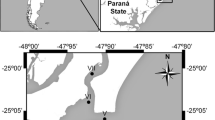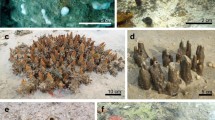Abstract
The association between sponges and the crab Inachus aguiarii Brito Capello, 1876 was studied by analysing the relationships between sponge distributional patterns on the crab carapaces and several morphological and biological crab parameters. Juveniles, mature females and mature males were differentiated on the basis of sex dimorphism and terminal pubertary moult. All three groups were fouled to different degrees by sponges. Percent sponge cover was related to carapace size only in mature males whereas mature females, all but one of which were ovigerous, were extensively covered regard-less of their size. It is proposed that some behavioural patterns unique to females, such as long resting periods in sponge-rich microhabitats, are responsible for these high sponge covers in females. Sponges showed two trends in the colonization of the carapace, leading to either a monopolizing or a sharing of the available carapace surface. The sponge species found on the carapaces studied are not obligatory epibionts of crabs, but are believed to reflect the sponge population characterizing the crab home range.
Similar content being viewed by others
Literature cited
Abelló, P., Villanueva, R., Gili, J. M. (1990). Epibiosis in deep-sea crab populations as indicator of biological and behavioural characteristics of the host. J. mar. biol. Ass. U.K. 70: 687–695
Addicot, J. F. (1984). Mutualistic interactions in population and community processes. In: Price, P. W., Slobodchikoff, C. N., Gaud, W. S. (eds.) Novel approaches to interactive systems. John Wiley & Sons, New York, p. 437–455
Arroyo, M. C., Uriz, M. J., Rubió, M. (1976). Inachus thoracicus (Crustacea Decapoda), substrato pasivo de Demospongia. Investigación pesq. 40(1): 15–57
Bloom, S. A. (1975). The motile escape response of a sessile prey: a sponge-scallop mutualism. J. exp. mar. Biol. Ecol. 17: 311–321
Bürgi, A. (1968). Contribution à l'étude du comportement vis-àvis d'objets étrangers chez les Majidae. Vie Milieu 2: 215–304
Charlisle, A. I. (1953). Observation on the behaviour of Dromia vulgaris Milne Edwards, with simple ascidians. Pubbl. Staz. zool. Napoli 24: 142–151
Dembowska, W. S. (1926). Study on the habits of the crab Dromia vulgaris M.E. Biol. Bull. mar. biol. Lab., Woods Hole 50: 163–178
Feifarek, B. P. (1987). Spines and epibionts as antipredator defenses in the thorny oyster Spondylus americanus Hermann. J. exp. mar. Biol. Ecol. 105: 39–56
Fenizia, G. (1935). La Dromia vulgaris (M. Edw.) e le sue abitudini. Archo. zool ital. 21: 509
Gundersen, H. J. G. (1984). Stereology and sampling of biological surfaces. In: Echelin, P. (ed.) Analysis of organic and biological surfaces. John Wiley & Sons, New York, p. 477–507
Hazlett, B., Rittschof, D. (1975). Daily movements and home range in Mithrax spinosissimus (Majidae, Decapoda). Mar. Behav. Physiol. 3: 101–118
Kramer, C. Y. (1956). Extension of multiples range tests to group means with unequal numbers of replication. Biometrics 12: 307–310
Legendre, L., Legendre, P. (1983). Numerical ecology. Elsevier, New York
McLay, C. L. (1983). Dispersal and use of sponges and ascidians as camouflage by Cryptodromia hilgendorfi (Brachyura: Dromiacea). Mar. Biol. 76: 17–32
Pielou, E. C. (1984). The interpretation of ecological data. John Wiley & Sons, New York
Pitcher, C. R., Butler, A. J. (1987). Predation by asteroids, escape response, and morphometrics of scallops with epizoic sponge. J. exp. mar. Biol. Ecol. 112: 233–249
Polimanti, O. (1911). Studi di fisiologia ecologica e sulla simbiosi di Suberites domuncula (Olivi) con la Dromia vulgaris (M. Edw.). Zool. Jb. (Abt. allg. Zool. Physiol. Tiere) 30: 359
Rützler, K. (1970). Spatial competition among Porifera: solution by epizoism. Oecologia 5: 85–95
Rützler, K. (1978). Sponges in coral reefs. In: Stoddart, D. R., Johanes, R. E. (eds.) Coral reefs: research methods. Monogr. oceanogr. Methodol. (UNESCO) 5: 299–313
Sará, M. (1970). Competition and cooperation in sponge populations. Symp. zool. Soc. Lond. 25: 273–284
Tukey, J. W. (1953). The problem of multiple comparisons. Department of Statistics, Princeton University
Vance, R. R. (1978). A mutualistic interaction between a sessile marine clam and its epibionts. Ecology 59(4): 679–685
Willians, R., Moyse, J. (1988). Occurrence, distribution, and orientation of Poecilasma kaempferi Darwin (Cirripedia: Pedunculata) epizoic on Neolithodes grimaldi Milne-Edwards and Bouvier (Decapoda: Anomura) in the Northeast Atlantic. J. Crustacean Biol. 8(2): 177–189
Author information
Authors and Affiliations
Additional information
Communicated by O. Kinne, Oldendorf/Luhe
Rights and permissions
About this article
Cite this article
Maldonado, M., Uriz, M.J. Relationships between sponges and crabs: patterns of epibiosis on Inachus aguiarii (Decapoda: Majidae). Marine Biology 113, 281–286 (1992). https://doi.org/10.1007/BF00347282
Accepted:
Issue Date:
DOI: https://doi.org/10.1007/BF00347282




